Abstract
Crystal blockages of tunnel drainage systems severely undermine the tunnel lining structure and operation safety. In order to reduce the risk of crystal blockages of tunnel drainage systems, the distribution of highway tunnel defects was identified through a field survey, indoor test, and literature analysis, and an optimization method of tunnel drainage structures was proposed. The research suggested the following: (1) Lining water leakage and construction joint water leakage were the most common defects in the tunnel drainage system of Renhua–Xinfeng Expressway and Yingde–Huaiji Expressway in Guangdong Province, accounting for 60% and 32% of total defects, respectively. The number of defects that occurred in the drainage system of the tunnel was larger in the granite formation, with the number of road seepage and inspection chamber crystallization incidents reaching 2.5/km and 2.8/km, respectively. (2) The groundwater was mainly alkaline with a pH value of 8~12, Ca2+ (107 mg/L) was the cation with the largest ion concentration, and HCO3− (165 mg/L) was the anion with the largest ion concentration. The crystals in the tunnel drainage system were predominantly square, spindle, and rhombic calcite and aragonite composed of CaCO3, mixed with a small amount of sediment. (3) To reduce the risk of crystal blockages of the tunnel drainage system and ensure tunnel lining structure safety, a threefold optimization measure was proposed, namely, setting one-directional drainage pipes between the cable trench and the roadside blind drainage ditch, applying “π” type anti-crystallization drainage water-stop belts at the circular construction joints in the secondary lining, and both increasing the slope of the transverse drainage pipe and using an anti-crystallization drainage pipe. The research results will play an important role in guiding the design, construction, and maintenance of highway tunnel drainage systems in China.
1. Introduction
Over the past decade, China has made many technological breakthroughs in tunnel construction, making it a tunnel powerhouse [1]. The construction and operation of tunnels lead to crystal blockage of tunnel drainage pipes (such as Chongqing [2], Yunnan [3], Sichuan [4], and Guizhou (Figure 1). After crystal blockage takes place in drainage pipes, the groundwater around the lining cannot be discharged from the tunnel in time, resulting in a number of defects such as increased water pressure in the lining, lining cracking and leakage, water overflow in the tunnel [5,6], severely threatening tunnel lining and operation safety.

Figure 1.
Crystalline plugging of tunnel drainage pipelines ((a): Chongqing; (b): Yunnan; (c): Sichuan; (d): Guizhou).
Rinder et al. believed that the precipitation produced by the chemical reaction when groundwater flowed through the initial support shotcrete and the crystallization resulting from environmental factors after the solution entered the drainage pipe were the main sources of crystals in the tunnel drainage pipe [7]. Zhang et al. found that crystals in the tunnel drainage system were predominantly calcite composed of CaCO3 [8]. Xiang Kun et al. concluded that the pH value of groundwater had a significant impact on the number of crystals, namely, the higher the pH value, the more likely it was to produce crystals in the drainage pipe [2]. Qian Zhenyu et al. suggested that the number of crystals in the drainage pipe was closely related to water flow rate and CaCO3 crystal purity [9]. Huang Zhouyi et al. proposed that the type of blockage was divided into non-crystalline and crystalline blockage based on the cause of the karst tunnel drainage system blockage [10]. The non-crystalline blockage was mainly associated with defects of construction and design, while crystalline blockage factors ranged from CO2 partial pressure, pH value, and temperature to hydrodynamic force. Jiang Yajun et al. inspected the drainage systems of over 20 tunnels with an endoscope and inspection robot, and divided tunnel drainage system defects into structural and functional ones [11].
Many scholars have conducted research on the prevention and treatment of the crystal blockage of tunnel drainage systems. Jung et al. found that quantum rods could be used for the treatment of the crystal blockage of tunnel drainage pipes under certain circumstances [12]. Zhou et al. proposed that placing a smooth coating on the inner wall of a drainage pipe could reduce crystallization [13]. Liu Shiyang et al. argued that flocking the drainage pipe wall could inhibit the crystal blockage [14,15]. Zhao Peng et al. developed a convenient and efficient dredging machine applicable for railway tunnel drainage systems [16]. Tian Chongming et al. and Ye Fei et al. discovered that optimizing the concrete mix ratio could prevent crystals from blocking drainage pipes [17,18].
Tunnel drainage system defect is inevitable. The major research areas for domestic and foreign scholars on the tunnel drainage system range from ion sources, crystal components, and influencing factors to prevention and treatment of crystal blockage, and field survey, numerical analysis, and macro-microscopic tests are adopted as the main research methods [19,20]. The research outcomes can provide a certain reference value to the prevention and treatment of the crystal blockage of tunnel drainage systems; however, the issue cannot be thoroughly addressed. The primary cause of crystal blockage in tunnel drainage systems is the interaction between groundwater and the supporting structure materials and the structural form of the drainage system. Therefore, the main research ideas of this paper are as follows: firstly, through field investigation and sampling, the ion composition in the groundwater where the tunnel is located is analyzed, and the composition of crystal blockage in the tunnel drainage system is determined. Secondly, through the field investigation, the location of the tunnel drainage system that is most prone to crystal blockage disease is determined, which provides a basis for the structural optimization of the drainage system. Finally, according to the existing research results of the team and the research results of other scholars, the drainage system structure is optimized to reduce the risk of crystallization blockage disease in the drainage system and ensure the safety and stability of the lining structure during the tunnel operation.
2. Field Survey and Sampling
The sampling points selected in this paper are mainly the tunnels of the Renxin Expressway and Yinghuai Expressway in Guangdong Province. In view of the crystalline blocking diseases of the tunnel drainage system, the structural optimization measures of the drainage system are explored. The research results have certain guiding significance for the design of the tunnel drainage system in Guangdong Province. The highway tunnels in other parts of the country can be properly adjusted according to their actual situation to reduce the risk of crystallization blockage in the tunnel drainage system. The crystallization blockage of the drainage system is mainly caused by the chemical reaction of anion and cation in groundwater. Therefore, it is necessary to collect groundwater samples and crystal samples, test and analyze the samples in the laboratory, and explore the improvement measures of drainage structure according to the analysis results.
By investigating the crystal blockage of the tunnel drainage system of Renhua–Xinfeng Expressway and Yingde–Huaiji Expressway in Guangdong Province (Figure 2), we identified the type, distribution form, and number of crystal blockages of the tunnel drainage system, performed a causative and factorial analysis on the defects of the tunnel drainage system, and provided suggestions for the prevention and control of crystal plugging of the tunnel drainage system. The survey locations were primarily distributed across the tunnel emergency parking zone, tunnel entrance, side wall, and crosswalk, and the rocks of the surveyed tunnel were largely slate, sandstone, granite, and quartzite. Table 1 shows the name of the tunnel and the specific survey locations.

Figure 2.
Tunnel site investigation ((a): Tunnel disease; (b): Site sampling; (c): Groundwater sample; (d): Crystal sample).

Table 1.
Site investigation and distribution of tunnels.
3. Analysis and Discussion
Tunnel defects caused by drainage system defects primarily include drainage ditch crystal blockage (A), construction joint water leakage (B), inspection chamber crystallization (C), lining water leakage (D), and road seepage (E), etc., among which the lining water leakage and construction joint water leakage are the most prevalent forms of defect, accounting for 60.35% and 32.67%, respectively. The share of other defects is shown in Figure 3. It can be learned from Table 2 that the roadside drainage ditch and adjacent cable trench are the predominant sites of crystal blockages of tunnel drainage system, with 60% of crystals being more than 10 cm thick (Table 2).
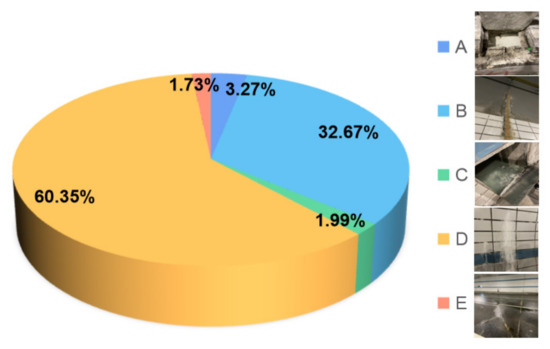
Figure 3.
Disease distribution of drainage system of the highway tunnel.

Table 2.
Tunnel crystallization blocking diseases.
Xie Yadong et al. found that the tunnel water leakage mostly occurred in the circular structural joints (construction joints and deformation joints) and longitudinal construction joints [21]. On one hand, through the above research data analysis, it was learned that the lining water leakage and construction joint water leakage were the most prevalent defects of the Renhua–Xinfeng Expressway and the Yingde–Huaiji Expressway. On the other, these two defects were mainly caused by the obstructed drainage resulting from the blockage of the tunnel drainage system. Liu Kun and Gao Chunjun et al. conducted a numerical analysis on crystal blockage of tunnel drainage pipes and found that the drainage system failed locally following crystal plugging, where the groundwater table was raised and water pressure increased following tunnel lining, ultimately leading to problems such as lining water leakage and construction joint water leakage [22,23].
The middle-buried type water-stop belt is often used at the construction joint, which cannot be completely fixed due to the limitations of its installation method. The quality defects of the construction joint in the tunnel lining can be divided into three main types: “crescent-shaped” cracking of concrete, deviation, and exposure of circular middle-buried type rubber water-stop belt, and loose concrete [24]. The construction quality of the water-stop belt directly affects the water-stop effect at the construction joint. When tunnel drainage pipes are blocked by crystals, the smoothness of the drainage system is compromised [25,26,27,28,29]. The groundwater that is not discharged timely will seep through defective construction joints and as groundwater seeps through concretes, chemical reactions will take place and, thus, crystallization follows [30].
Per field conditions, it can be extrapolated that crystal blockage of the inspection chamber and roadside drainage ditch is also related to the crystal plugging of the transverse drainage pipe. When transverse drainage pipes are plugged by crystals, groundwater cannot be discharged as usual. Thus, a large volume of crystal-carrying groundwater inverts into the inspection chamber and deposits in the drainage ditch, resulting in crystal blockage.
By sorting the defects of different tunnels and surrounding rock conditions, the number of defects per kilometer under various geological conditions is calculated according to Formula (1). The analysis shows that: when the rock of the tunnel is mostly made of granite, the number of construction joint water leakage, lining water leakage, road seepage, and inspection chamber crystallization is the largest, reaching 35/km, 58/km, 2.5/km, and 2.8/km, respectively. When limestone makes up the majority of the tunnel rock constituents, the number of drainage ditch crystal plugging is the largest, reaching 8.8/km (Figure 4).

Figure 4.
Number of diseases per kilometer under various geological conditions ((a): types accounting for more than 20%; (b): types accounting for less than 10%.).
η = M/L
- η—Number of defects per kilometer (place/km);
- M—Number of defects under a certain geological condition (place);
- L—Tunnel length (km).
The research shows that the crystalline plugs of the tunnel drainage system are mainly calcium carbonate and magnesium carbonate [2,3]. Therefore, Ca2+, Mg2+, HCO3−, and CO32− are mainly selected for groundwater analysis, while Na+, K+, Cl−, and SO42− are alkaline and acidic ions, which have an impact on the pH value of groundwater. Some scholars have pointed out that the pH value of groundwater has an important influence on the crystallization of calcium carbonate [2], so these ions are also considered in the analysis of groundwater. The analysis of groundwater is mainly entrusted to a professional organization, which also carries out groundwater detection and analysis in strict accordance with national standards, mainly in accordance with the glass electrode method in the standard DZ/T 0064.5-2021.
The test and analysis of water samples show that the chemical type of groundwater investigated on site is mainly of the CO3Ca type. Literature [17] pointed out that there was severe crystallization for groundwater containing NaHCO3 in tunnels under construction, and HCO3− had not been fully involved in chemical reactions during tunnel construction. As the operation of the tunnel goes on, the CO2 partial pressure gradually decreases, and HCO3− gradually reacts with Ca2+ to form CaCO3 [31]. When the calcium ions are insufficient, the excess HCO3− dissociates into CO32− [32,33], which makes CaCO3 the primary mineral component in the groundwater of the tunnel in operation. The average concentration of Ca2+ in the surveyed groundwater samples is 64.7 mg/L, and the average concentration of CO32− is 16.8 mg/L, providing conditions for CaCO3 generation.
The crystal microanalysis was entrusted to a professional organization, and the XRD test was conducted with Cu Target and Kα Radiation, 1 mm/8 mm/2.5°/NI filter. The slit system adopts DS (divergent slit): 1°, wavelength: 1.540 Å, working voltage 40 kV, working current 40 mA, starting angle (2θ) 10°, termination angle (2θ) 90°, step length 0.01°, step speed 2 deg/min; temperature 23 °C, and humidity 41%. Generally speaking, the diffraction peak of calcite will appear at the position with 2θ angles of 29°, while the diffraction peak of aragonite will appear at the positions with 2θ angles of 26° and 46°. XRD diffraction spectroscopy analysis (Figure 5) of the crystal samples suggested the crystal composition overlapped the most with the CaCO3 of calcite and aragonite, with a matching degree of up to 97%, and only a small number of crystal samples contained gravel composed of quartz, indicating that the crystal blocking the operating tunnel drainage system was mainly CaCO3. In addition to CaCO3, trace amounts of magnesium and barium salts and other metal compounds were present in the crystal samples. SEM scanning results (Figure 6) showed that besides the prevalent crystal block packing, there were also “needle-shaped clusters” and “bone-shaped cohesion”. The larger the pH value, the more the crystal type was spindle-shaped, the tighter the packing, and the smaller and more uniform the grain size [3]. Due to the influence of different environments and geological conditions, the crystals were different in microscopic packing form, but the overall crystal form was in line with the crystal form characteristics of CaCO3, being square, spindle, and rhombic.
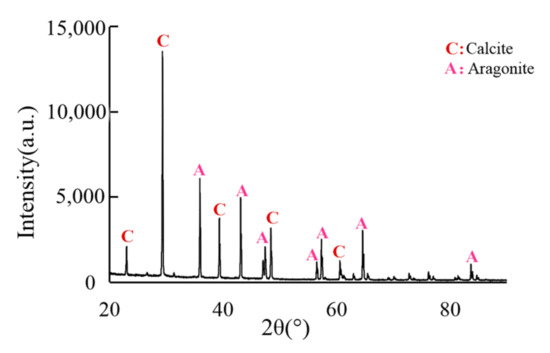
Figure 5.
XRD diffraction pattern of crystal sample.

Figure 6.
SEM micro morphology of crystal ((a): 500 times; (b): 1000 times; (c): 2000 times; (d): 8000 times).
There are four isomers of CaCO3 crystals and in the order of crystal stability from the lowest to the highest, they are gelatinous CaCO3, vaterite, aragonite, and calcite, successively, among which aragonite and calcite are the most common ones [34]. The microscopic analysis of CaCO3 crystals suggested that the CaCO3 crystals of the tunnel drainage system under construction were mostly calcite [8,25,35,36], while the CaCO3 crystals of the tunnel drainage system in operation were primarily calcite and aragonite.
Tests of the groundwater samples showed that the pH value of all groundwater samples was greater than seven, making the groundwater alkaline [37,38,39,40]. The pH value of the strongest alkaline groundwater samples reached 11.52, and 74% of the groundwater samples showed a pH value of over 9 (Figure 7). Related studies indicated that the precipitation rate of calcite was the highest when the pH value approached 10 [7]; the lower the pH value, the higher the dissolution of CaCO3 in the surrounding soil [41]; the crystal amount in drainage pipes increased with the pH value [3]. It well justifies the presence of crystal plugging in the surveyed tunnel drainage system.

Figure 7.
pH value distribution of tunnel groundwater.
4. Exploration of Drainage Structure
The on-site investigation has enabled us to understand the chemical composition of crystallization blockages in the drainage system, and determined the structural components (horizontal drainage pipe, construction joint, cable trench, etc.) that are most prone to crystallization blockage. We can look for measures to improve the drainage structure from these aspects.
Through the field survey of the tunnel drainage structure of the Renhua–Xinfeng Expressway and the Yingde–Huaiji Expressway, it was learned that crystal blockages were not only found in the longitudinal drainage pipe (Figure 8a), transverse drainage pipe (Figure 8b), and roadside blind drainage ditch (Figure 8c) behind the lining, but also in the cable trench (Figure 8d). The crystal plugging of the tunnel drainage structure gradually gave rise to a number of defects, such as inspection chamber overflow, lining cracking and leakage, and construction joint water leakage. Therefore, drawing on relevant research results, this paper optimized the sites where crystal plugging of the tunnel drainage structure could take place to prevent crystallization, and thus reduce the maintenance costs of the tunnel drainage system.

Figure 8.
Crystal disease of tunnel drainage structure ((a): longitudinal drainage pipe; (b): transverse drainage pipe; (c): roadside underdrain; (d): cable trench).
For the horizontal drainage pipe, scholars’ research shows that the groundwater velocity has a significant impact on crystallization, and one of the methods to directly change the velocity is to increase the slope of the drainage pipe, so the measures to change the slope of the drainage pipe are considered. In view of the crystallization blockage at the lining construction joint, most of the waterstops at the construction joint are mainly used for water plugging, but the groundwater cannot be completely blocked, so it is considered to propose a drainage waterstop that can not only block water, but also prevent crystallization. In view of the crystallization problem in the cable trench, the idea of introducing the water in the cable trench into the side trench is considered to avoid a large amount of ponding in the cable trench and effectively protect the cables in the cable trench.
4.1. Adding Transverse Drainage Pipes to Cable Trenches
The Code for Design of Road Tunnel stipulates that measures should be taken to prevent water accumulation in cable trenches [42]. Figure 9 shows the design drawing of most cable trenches in China at present. Discharge leakage water in cable trenches resulting from the lining cracking is not taken into consideration, and thus crystal blockages occur in cable trenches (Figure 8d). Therefore, a new drainage design is introduced at the outer bottom of the new tunnel cable trench. Specifically, a transverse drainage pipe is placed at a 50 m interval between the cable trench and the roadside blind drainage ditch longitudinally. The pipes (adopting 50PE) are set at the inspection chamber of the roadside blind drainage ditch (Figure 10). The pipes are one-way designed to only allow groundwater to flow from the cable trench to the roadside drainage ditch, but not the other way around, thus avoiding backflow to the cable trench in rainy seasons when the volume of groundwater increases in the roadway drainage ditch.
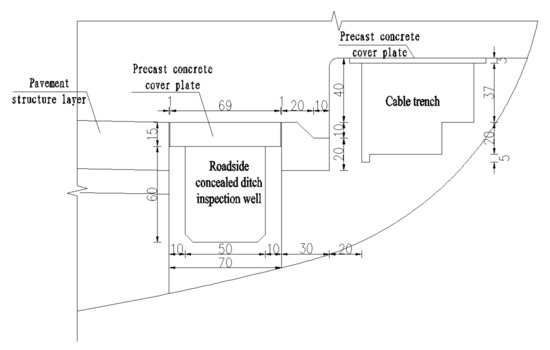
Figure 9.
Design drawing of cable trench in China at the present stage (dimensions in the drawing are in cm).
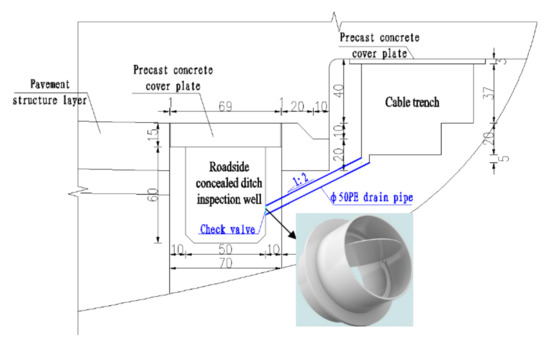
Figure 10.
Design drawing of optimized cable trench (dimensions in the drawing are in cm).
4.2. Novel Anti-Crystallization Drainage Water-Stop Belts for Construction Joints
The research results showed that 32.67% of the total defects were attributable to construction joint water leakage resulting from functional loss of the water-stop belt. Therefore, it is necessary to optimize the structure of the circular construction joint. When installing the conventional middle-buried type water-stop belt, the belt is fixed between the initial support and the secondary lining with an end formwork. The inner and outer end formwork of the water-stop belt needs to be installed in blocks. This installation method is complex and difficult, and the formwork around the water-stop belt is prone to be poorly sealed. When pouring the lining concrete, the reinforcing bar in the lining is likely to damage the end formwork of the water-stop belt, which makes it difficult to compact the area around the belt. These influencing factors ultimately lead to belt deviation, thus compromising the water-stop effect.
In order to solve this problem, a new type of “π” type anti-crystallization drainage water-stop belt is proposed. In addition to conventional water-stop performance, this novel water-stop belt also has a drainage function. The internal semicircular hose can divert the groundwater pouring into the construction joint behind the lining into the longitudinal drainage pipe, substantially reducing water pressure on the belt and making the belt more stable, thus achieving a better water drainage performance. At the same time, the new water-stop belt is also designed to prevent crystal plugging of the tunnel drainage pipe thanks to the fluff layer on the inner wall of the drainage pipe. The anti-crystallization effect of the flocked drainage pipe has been verified in the literature [14,19].
The structure of the “π” type anti-crystallization drainage water-stop belt is shown in Figure 11 and consists of a water-stop edge, water-stop wing, geotextile, fluff, semicircular hose, and slot. Among them, the slot functions as a semicircular hose fixer. The water-stop edge placed on the wing ensures that the belt can be better secured in the secondary lining concrete without the risk of being pulled out, thus avoiding belt deviation from the shocks produced amid concrete vibration and construction. The geotextile at the top acts to block and filter the groundwater behind the lining. When a tunnel is being built, it can prevent impurities such as slurry, sand, and stone from entering the semicircular hose to destroy the fluff layer and undermine the anti-crystallization properties of the water-stop belt. When a tunnel is in operation, it filters the groundwater flowing into the construction joint. The schematic diagram for the construction and installation of the “π” type anti-crystallization drainage water-stop belt is shown in Figure 12.
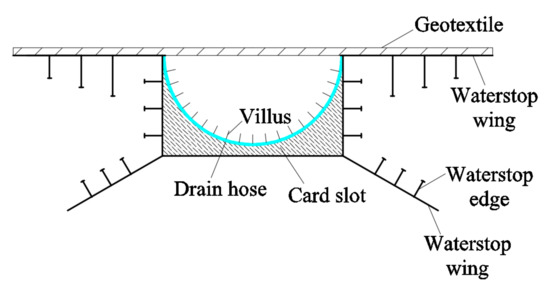
Figure 11.
Structural diagram of “π” anti-crystallization drainage waterstop.
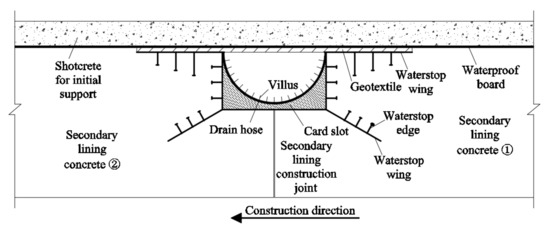
Figure 12.
Construction and installation diagram of “π” anti-crystallization drainage waterstop.
Compared with the conventional middle-buried type and back-stick type water-stop belts, the advantages of the “π” type anti-crystallization drainage water-stop belt are as follows:
- (1)
- Built-in drainage function. It can reduce the installation of the circular blind pipe, reduce the occurrence of the construction joint and lining water leakage in the tunnel operation phase, and effectively reduce the total cost and maintenance cost of tunneling, generating evident economic benefits;
- (2)
- The end formwork required for installation is reusable, and zero loss installation can be achieved requiring no disconnection of the end formwork or rebar fixture as an auxiliary tool;
- (3)
- When installing the conventional middle-buried type water-stop belt, the belt is placed in the middle of the lining, and reinforcing bars are trussed and secured by installing a fixture, complicating construction steps. While the novel water-stop belt fixation only requires the end formwork to be inserted in the middle of the water-stop wings below the “π” type belt on both sides, greatly shortening the installation time and improving the installation speed.
4.3. Optimization of the Material and Slope of Transverse Drainage Pipes
Pipe wall roughness is a major factor influencing the crystallization rate of the tunnel drainage pipe. It is followed by the slope of the pipe wall, which can affect the water flow state by controlling the flow rate, and thus affect the crystallization rate of karst water [19,20]. In the tunnel drainage system, the most straightforward way to increase the groundwater flow rate in the drainage pipe is to increase its slope. The Code for Design of Road Tunnel stipulates that the slope for the tunnel transverse drainage pipe shall not be less than 1% [42]. Under the influence of construction factors, this slope cannot effectively prevent crystal generation in the drainage pipe. Therefore, the slope of the transverse drainage pipe was adjusted to around 5~8% for crystal prevention in light of the thickness of the secondary lining and the position height difference of the roadside drainage ditch. (Figure 13). The φ110 semicircular drainage pipe was adopted as the circular blind pipe. One circular φ110 drainage pipe was set between the initial support and the surrounding rock and another between the initial support and the waterproof board, and connected to the longitudinal drainage pipe (Figure 14). Part of the groundwater in the longitudinal drainage pipe was discharged horizontally into the roadside drainage ditch through the T-shaped three-way pipe (Figure 15). At the same time, the transverse drainage pipe with anti-crystallization properties was applied [13,19].
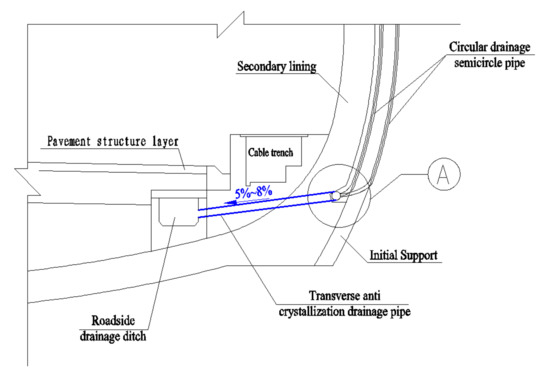
Figure 13.
Schematic diagram of optimization of drainage slope of transverse drainage pipe.
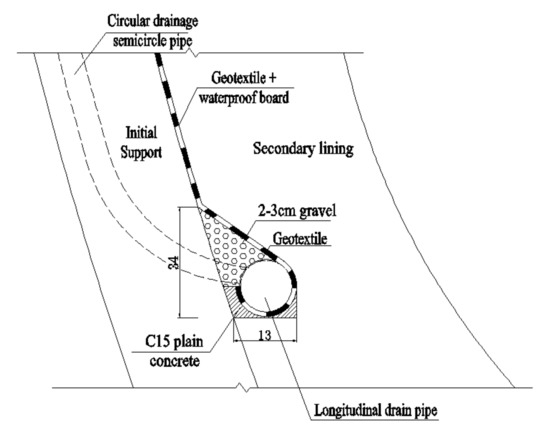
Figure 14.
Schematic diagram of the connection between the circumferential drain pipe and longitudinal drain pipe (unit: cm in the figure).
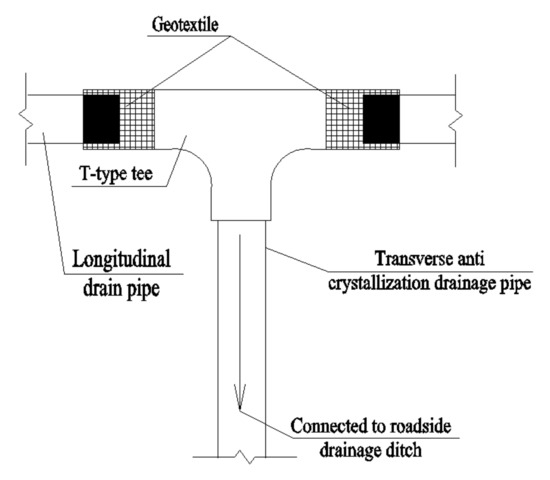
Figure 15.
Connection diagram of longitudinal drainage pipe and transverse anti-crystallization drainage pipe.
5. Conclusions
- (1)
- Lining water leakage and construction joint water leakage were the most prevalent defects in the tunnel drainage system of the Renhua–Xinfeng Expressway and the Yingde–Huaiji Expressway in Guangdong Province, accounting for 60% and 32% of total defects, respectively. The number of defects was greater in the drainage system of the tunnel containing granite, with the number of road seepages and inspection chamber crystallizations reaching 2.5/km and 2.8/km, respectively.
- (2)
- The groundwater was predominantly alkaline with a pH value of 8~12, Ca2+ (107 mg/L) was the cation with the largest ion concentration, and HCO3− (165 mg/L) was the anion with the largest ion concentration. Crystals in the tunnel drainage system were primarily square, spindle, and rhombic calcite and aragonite composed of CaCO3, mixed with a small amount of sediment.
- (3)
- To reduce the risk of crystal plugging of the tunnel drainage system and ensure the safety of the tunnel lining structure, a threefold structural optimization approach was proposed, namely, placing one-way drainage pipes between the cable trench and the roadside drainage ditch, applying “π” type novel anti-crystallization drainage water-stop belts at the circular construction joints in the secondary lining, and both increasing the slope of the transverse drainage pipes and using anti-crystallization drainage pipes.
Author Contributions
Conceptualization, X.Z.; methodology, S.L.; software, S.L.; validation, X.Z.; formal analysis, S.L.; investigation, X.C., C.W. and Y.C.; resources, X.Z.; data curation, X.C., C.W. and Y.C.; writing—original draft preparation, S.L.; writing—review and editing, X.Z.; visualization, S.L.; supervision, X.Z.; project administration, X.Z.; funding acquisition, X.Z. All authors have read and agreed to the published version of the manuscript.
Funding
This research was financially supported by the Scientific Research Project of the Emei-Hanyuan Expressway Project (Grant No. LH-HT-45), the Shixing Connecting Line Project of Wuhan Shenzhen Expressway (WLX (202107) YS1-001), the Sub Project of National Key R&D Plan (2021YFB2600103-01), the Cooperation between Chongqing University and the Institute of Chinese Academy of Sciences (HZ2021009), and Chongqing Postgraduate Joint Training Base Construction Project (JDLHPYJD2021003).
Institutional Review Board Statement
Not applicable.
Informed Consent Statement
Not applicable.
Data Availability Statement
The study did not report any data.
Conflicts of Interest
The authors declare no conflict of interest.
References
- Hong, K.R.; Feng, H.H. Development trends and views of highway tunnels in china over the past decade. China J. Highw. Transp. 2020, 33, 62–76. [Google Scholar]
- Xiang, K.; Zhou, J.; Zhang, X.F.; Huang, C.; Song, L.; Liu, S.Y. Experimental study on crystallization rule of tunnel drainpipe in alkaline environment. Tunn. Constr. 2019, 39, 207–212. [Google Scholar]
- Ye, F.; Tian, C.M.; Zhao, M.; He, B.; Wang, J.; Han, X. The disease of scaling and cloging in the drainage pipes of a tunnel under construction in Yunnan. China Civ. Eng. J. 2020, 53, 336–341. [Google Scholar]
- Li, H.M.; Liu, S.Y.; Xiong, S.A.; Leng, H.; Chen, H.Q.; Zhang, B.; Liu, Z. Laboratory experimental study on influencing factors of drainage pipe crystallization in highway tunnel in karst area. Coatings 2021, 11, 1493. [Google Scholar] [CrossRef]
- Shin, J.H.; Lee, I.K.; Joo, E.J. Behavior of double lining due to long-term hydraulic deterioration of drainage system. Struct. Eng. Mech. 2014, 52, 1257–1271. [Google Scholar] [CrossRef]
- Liu, K.; Liu, X.R.; Zhong, Z.L.; Li, Y. Analysis on stress and stability of lining in partially-blocked tunnel drainage system. J. Eng. Sci. Technol. Rev. 2017, 10, 139–149. [Google Scholar] [CrossRef]
- Rinder, T.; Dietzel, M.; Leis, A. Calcium carbonate scaling under alkaline conditions—Case studies and hydrochemical modelling. Appl. Geochem. 2013, 35, 132–141. [Google Scholar] [CrossRef]
- Zhang, X.F.; Zhou, Y.F.; Zhang, B.; Zhou, Y.J.; Liu, S.Y. Investigation and analysis on crystallization of tunnel drainage pipes in chongqing. Adv. Mater. Sci. Eng. 2018, 2018, 7042693. [Google Scholar] [CrossRef] [Green Version]
- Qian, Z.Y.; Peng, H.H.; Lv, J.B.; Chen, G.F. Experimental study on chemical crystallization and siltation in drainage pipe of limestone tunnel in south china. Mod. Tunn. Technol. 2021, 58, 143–149. [Google Scholar]
- Huang, Z.Y.; Qi, C.F.; Xu, R.H.; Wang, Y.D.; Jiang, D.R. Analysis of factors influencing the blocking of tunnel drainage system in karst area. Mod. Transp. Technol. 2020, 17, 46–51. [Google Scholar]
- Jiang, Y.J.; Liu, S.G.; Zhou, R.; Lin, L.D.; Xiao, H.R. Study on causes and grade of disasters in lining drainage system of operating transportation tunnel. Railw. Stand. Des. 2022, 66, 124–129. [Google Scholar]
- Jung, H.S.; Han, Y.S.; Chung, S.R.; Chun, B.S.; Lee, Y.J. Evaluation of advanced drainage treatment for old tunnel drainage system in Korea. Tunn. Undergr. Space Technol. 2013, 38, 476–486. [Google Scholar] [CrossRef]
- Zhou, Y.; Zhang, X.; Wei, L.; Liu, S.; Zhou, C. Experimental study on prevention of calcium carbonate crystallizing in drainage pipe of tunnel engineering. Adv. Civ. Eng. 2018, 2018, 9430517. [Google Scholar] [CrossRef] [Green Version]
- Liu, S.Y.; Zhang, X.F.; Lu, H.Y.; Liu, Q.; Wang, B. The effect of flocking pvc pipe on the prevention and crystallization of tunnel drains. Sci. Technol. Eng. 2018, 18, 313–319. [Google Scholar]
- Liu, S.Y.; Zhang, X.F.; Lu, H.Y.; Liu, Q.; Wang, B. The effect of anti-crystallization of tunnel plumage drain pipe under different water filling state. Sci. Technol. Eng. 2018, 18, 156–163. [Google Scholar]
- Zhao, P.; Guo, X.X.; Ma, W.B. Research and application of dredge equipment for drainage pipeline in railway tunnel. Railw. Eng. 2018, 58, 30–32. [Google Scholar]
- Tian, C.M.; Ye, F.; Song, G.F.; Wang, Q.L.; Zhao, M.; He, B.; Wang, J.; Han, X.B. On mechanism of crystal blockage of tunnel drainage system and preventive countermeasures. Mod. Tunn. Technol. 2020, 57, 66–76. [Google Scholar]
- Ye, F.; Tian, C.M.; He, B.; Zhao, M.; Wang, J.; Han, X.B.; Song, G.F. Crystallization clogging test of drainage system under construction. J. China Highw. 2021, 34, 159–170. [Google Scholar]
- Liu, S.Y.; Gao, F.; Zhang, X.F.; Han, F.L.; Zhou, Y.F.; Xiang, K.; Xiao, D.J. Experimental study on anti-crystallization law of tunnel transverse flocking drainpipe at different velocities. Asia Pac. J. Chem. Eng. 2020, 15, e2470. [Google Scholar] [CrossRef]
- Wang, Y.D.; Liu, Y.; Qi, C.F.; Zhou, T.Y.; Ye, M.; Wang, T. Crystallization law of karst water in tunnel drainage system based on DBL theory. Open Phys. 2021, 19, 241–255. [Google Scholar] [CrossRef]
- Xie, Y.D.; Lv, Z.Q.; Liu, P. Optimization of waterproof construction technology for lining structural joints of water-rich mountain tunnel. Highway 2020, 65, 151–155. [Google Scholar]
- Liu, K.; Liu, X.R.; Zhong, Z.L.; Yi, L.; Wang, S. Regulation of external water pressure of tunnel lining with asymmetric blocked drainage system. Chin. J. Undergr. Space Eng. 2018, 14, 369–378. [Google Scholar]
- Gao, C.J.; Xiang, L.H.; Zhang, X.F.; Zhou, Y.F.; Liu, S.Y. Lining stress caused by crystal lization clogging of tunnel drainage pipe at different water levels. J. Chongqing Jiaotong Univ. 2019, 38, 45–51. [Google Scholar]
- Zhang, M.Q.; Jia, D.P.; Xin, W.K.; Wang, S.S.; Li, F.Y. New quality control technology of the railway tunnel lining construction joints. J. Railw. Eng. Soc. 2021, 38, 59–64. [Google Scholar]
- Xu, D.; Liu, J.; Ma, T.; Zhao, X.F.; Ma, H.; Li, J. Coupling of sponge fillers and two-zone clarifiers for granular sludge in an integrated oxidation ditch. Environ. Technol. Innov. 2022, 26, 102264. [Google Scholar] [CrossRef]
- Chen, F.X.; Jin, Z.Q.; Wang, E.D.; Wang, L.Q.; Jiang, Y.D.; Guo, P.F.; Gao, X.Y.; He, X.Y. Relationship model between surface strain of concrete and expansion force of reinforcement rust. Sci. Rep. 2021, 11, 4208. [Google Scholar] [CrossRef]
- Chen, F.X.; Zhong, Y.C.; Gao, X.Y.; Jin, Z.Q.; Wang, E.D.; Zhu, F.P.; Shao, X.X.; He, X.Y. Non-Uniform Model of Relationship between Surface Strain and Rust Expansion Force of Reinforced Concrete. Sci. Rep. 2021, 11, 8741. [Google Scholar] [CrossRef]
- Wang, Y.; Wang, H.; Zhou, B.; Fu, H. Multi-dimensional prediction method based on Bi-LSTMC for ship roll. Ocean Eng. 2021, 242, 110106. [Google Scholar] [CrossRef]
- Li, X.S.; Wang, Y.M.; Hu, Y.J.; Zhou, C.B.; Zhang, H. Numerical Investigation on Stratum and Surface Deformation in Underground Phosphorite Mining under Different Mining Methods. Front. Earth Sci. 2022, 10. [Google Scholar] [CrossRef]
- Ye, F.; He, B.; Tian, C.M.; Zhao, M.; Armaghani, D.J. Influence of sodium aluminate on calcium leaching of shotcrete in tunnels. Tunn. Undergr. Space Technol. 2021, 117, 104156. [Google Scholar] [CrossRef]
- Kauffman, G.B. VM Goldschmidt (1888–1947): Modern geochemical pioneer. S. Afr. J. Sci. 1998, 94, 203–206. [Google Scholar]
- Tantardini, C.; Oganov, A.R. Thermochemical electronegativities of the elements. Nat. Commun. 2021, 21, 22429. [Google Scholar] [CrossRef] [PubMed]
- Tantardini, C.; Benassi, E. Topology vs. thermodynamics in chemical reactions: The instability of PH5. Phys. Chem. Chem. Phys. 2017, 19, 27779–27785. [Google Scholar] [CrossRef] [PubMed] [Green Version]
- Liu, W. Experiment and mechanism of magnetic treatment for water scale prevention. Water Wastewater Eng. 2008, 1, 62–65. [Google Scholar]
- Jiang, Y.J.; Du, K.; Tao, L.; Zhao, J.M.; Xiao, H.R. Investigation and discussion on blocking mechanism of drainage system in karst tunnels. Railw. Stand. Des. 2019, 63, 131–135. [Google Scholar]
- Guo, X.X. Crystall ization m echanism and countermeasures of drainage system for railway tunnel. China Railw. Sci. 2020, 41, 71–77. [Google Scholar]
- Sun, R.; Wang, J.; Cheng, Q.; Mao, Y.; Ochieng, W.Y. A new IMU-aided multiple GNSS fault detection and exclusion algorithm for integrated navigation in urban environments. GPS Solut. 2021, 25, 147. [Google Scholar] [CrossRef]
- Cheng, H.; Sun, L.; Wang, Y.; Chen, X. Effects of actual loading waveforms on the fatigue behaviours of asphalt mixtures. Int. J. Fatigue 2021, 151, 106386. [Google Scholar] [CrossRef]
- Yan, W.G.; Cao, M.H.; Fan, S.Q.; Liu, X.H.; Liu, T.; Li, H.S.; Su, J. Multi-yolk ZnSe/2(CoSe2)@NC heterostructures confined in N-doped carbon shell for high-efficient sodium-ion storage. Compos. Part B Eng. 2021, 213, 108732. [Google Scholar] [CrossRef]
- Wang, G.; Liu, D.; Fan, S.; Li, Z.; Su, J. High-k erbium oxide film prepared by sol-gel method for low-voltage thin-film transistor. Nanotechnology 2021, 32, 215202. [Google Scholar] [CrossRef]
- Wu, Z.L.; Cui, Y.G.; Antoine, G.B.; Miguel, M.M.; Deng, Y.F. Role of surrounding soils and pore water in calcium carbonate precipitation in railway tunnel drainage system. Transp. Geotech. 2019, 21, 100257. [Google Scholar] [CrossRef]
- JTG 3370.1-2018; Specifications for Design of Highway Tunnels Section 1 Civil Engineering. People’s Communications Publishing House Co., Ltd.: Beijing, China, 2018.
Publisher’s Note: MDPI stays neutral with regard to jurisdictional claims in published maps and institutional affiliations. |
© 2022 by the authors. Licensee MDPI, Basel, Switzerland. This article is an open access article distributed under the terms and conditions of the Creative Commons Attribution (CC BY) license (https://creativecommons.org/licenses/by/4.0/).